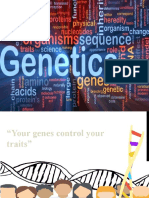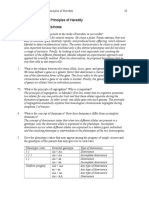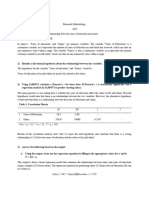0 ratings0% found this document useful (0 votes)
16 viewsBiology Test Revision
Biology Test Revision
Uploaded by
Ralph Rezin Moore1. The document provides examples and questions to test understanding of key biology concepts like Punnett squares, pedigree charts, and natural selection. It includes examples of using Punnett squares to determine genotype and phenotype percentages for traits like eye color and fur color in offspring.
2. Questions assess understanding of inheritance patterns from pedigree charts, including identifying modes of inheritance and drawing Punnett squares.
3. Other questions focus on natural selection, including how variation arises, selective pressures, adaptations, and how selection can change allele frequencies and populations over time.
Copyright:
© All Rights Reserved
Available Formats
Download as PPTX, PDF, TXT or read online from Scribd
Biology Test Revision
Biology Test Revision
Uploaded by
Ralph Rezin Moore0 ratings0% found this document useful (0 votes)
16 views13 pages1. The document provides examples and questions to test understanding of key biology concepts like Punnett squares, pedigree charts, and natural selection. It includes examples of using Punnett squares to determine genotype and phenotype percentages for traits like eye color and fur color in offspring.
2. Questions assess understanding of inheritance patterns from pedigree charts, including identifying modes of inheritance and drawing Punnett squares.
3. Other questions focus on natural selection, including how variation arises, selective pressures, adaptations, and how selection can change allele frequencies and populations over time.
Copyright
© © All Rights Reserved
Available Formats
PPTX, PDF, TXT or read online from Scribd
Share this document
Did you find this document useful?
Is this content inappropriate?
1. The document provides examples and questions to test understanding of key biology concepts like Punnett squares, pedigree charts, and natural selection. It includes examples of using Punnett squares to determine genotype and phenotype percentages for traits like eye color and fur color in offspring.
2. Questions assess understanding of inheritance patterns from pedigree charts, including identifying modes of inheritance and drawing Punnett squares.
3. Other questions focus on natural selection, including how variation arises, selective pressures, adaptations, and how selection can change allele frequencies and populations over time.
Copyright:
© All Rights Reserved
Available Formats
Download as PPTX, PDF, TXT or read online from Scribd
Download as pptx, pdf, or txt
0 ratings0% found this document useful (0 votes)
16 views13 pagesBiology Test Revision
Biology Test Revision
Uploaded by
Ralph Rezin Moore1. The document provides examples and questions to test understanding of key biology concepts like Punnett squares, pedigree charts, and natural selection. It includes examples of using Punnett squares to determine genotype and phenotype percentages for traits like eye color and fur color in offspring.
2. Questions assess understanding of inheritance patterns from pedigree charts, including identifying modes of inheritance and drawing Punnett squares.
3. Other questions focus on natural selection, including how variation arises, selective pressures, adaptations, and how selection can change allele frequencies and populations over time.
Copyright:
© All Rights Reserved
Available Formats
Download as PPTX, PDF, TXT or read online from Scribd
Download as pptx, pdf, or txt
You are on page 1of 13
Drawing Punnett squares
Biology Test Revision Solving pedigree charts
Describing the change of a population
undergoing natural selection and it’s causes
Key words
• Autosomal • Punnett square • Species
chromosomes • Dominant • Biodiversity
• Sex chromosomes • Recessive • Variation
• Allele • Trait • Selection pressure
• Allele frequency • Autosomal dominant • Adaptation
• Genotype • Autosomal recessive • Natural selection
• Phenotype • X-linked recessive • Artificial selection
• Homozygous • Pedigree chart • Population
• Hemizygous • Generations
• Heterozygous
Punnett Squares
1. The allele for blue eyes is "t" while the allele for brown eyes is
"T". What percentage of offspring produced by two parents with
blue eyes would also have blue eyes?
Draw a punnet square and calculate the genotype/phenotype % as
evidence for your answer.
Punnett Squares
2. The allele for longer necks in giraffes is dominant to the allele
for shorter necks. What are the phenotypes of the cross between
two homozygous parents, one with a long neck and one with a
short neck?
Draw a punnet square and calculate the genotype/phenotype % as
evidence for your answer.
Punnett Squares
3. Brown fur is dominant to white fur in a species of rabbit and is
represented with the alleles "B" and "b". What are the resulting
percentages of genotypes of a cross between a homozygous
dominant parent and a heterozygous parent?
Draw a punnet square and calculate the genotype/phenotype % as
evidence for your answer.
Punnett Squares
4. Colour blindness is an x-linked recessive genetic disorder. If a
heterozygous mother had children with a father with normal
vision, what would be the chances of producing children with
colour blindness?
Draw a punnet square and calculate the genotype/phenotype % as
evidence for your answer.
Punnett Squares
5. Why are males more susceptible to getting x-linked disorders
than females?
6. What is the difference between an allele, a genotype and a
trait?
7. List two autosomal recessive traits, two autosomal dominant
traits and two x-linked recessive traits.
Pedigree Charts
1. Identify the type of inheritance
2. Write the genotypes of every
individual
3. Draw a punnett square to prove
the genotypes of individuals I-1,
I-2, II-4 and II-5
Pedigree Charts
1. Identify the type of
inheritance
2. Write the genotypes of
every individual
3. Draw a punnett square to
prove the genotypes of all
individuals
Pedigree Charts
This pedigree chart shows the
inheritance pattern of haemophilia.
1. Explain how this chart shows
evidence of haemophilia being an
x-linked recessive disease.
Natural Selection
1. How does variation such as a
bird with a longer beak than
others of its species come about?
2. What selection pressure does
a longer beak give an advantage
for?
Natural Selection
1. Identify the adaptation and
selection pressure in this comic.
2. Explain the changes of allele
frequency and therefore the
changes to the population of
seals.
Natural Selection
1. Describe how each picture is
related to natural selection or
artificial selection.
2. What might be the
motivations for these changes to
occur in wolves and teosinte?
You might also like
- Methods OT Lee Revision Series SOLUTIONSDocument114 pagesMethods OT Lee Revision Series SOLUTIONSRalph Rezin MooreNo ratings yet
- Methods OT Lee Textbook NOT COMPRESSED (HIGHER QUALITY)Document265 pagesMethods OT Lee Textbook NOT COMPRESSED (HIGHER QUALITY)Ralph Rezin MooreNo ratings yet
- Handout - NonMendelian Inheritance WebquestDocument4 pagesHandout - NonMendelian Inheritance Webquestnick m (kraken)50% (2)
- Biology WA ATAR Units 3 & 4 Student Book With 1 X 26 Month NelsonNetBook Access CodeDocument547 pagesBiology WA ATAR Units 3 & 4 Student Book With 1 X 26 Month NelsonNetBook Access CodeRalph Rezin Moore100% (1)
- Punnett Square WorksheetDocument9 pagesPunnett Square WorksheetBeatrice AnnNo ratings yet
- Genetics Nonmendelian 150722002319 Lva1 App6891 PDFDocument81 pagesGenetics Nonmendelian 150722002319 Lva1 App6891 PDFLeby Fastidio100% (1)
- Chapter 3: Basic Principles of HeredityDocument18 pagesChapter 3: Basic Principles of HereditydthtlqNo ratings yet
- Population Genetics ProblemsDocument4 pagesPopulation Genetics ProblemsRahul KumarNo ratings yet
- L2 Biol261F2014Document37 pagesL2 Biol261F2014jdazuelosNo ratings yet
- Punnett SquareDocument24 pagesPunnett Squareyumeko.deluluNo ratings yet
- Genetika ZadaciDocument85 pagesGenetika ZadaciAmar ZahirovicNo ratings yet
- O o o oDocument4 pagesO o o oAsif Jutt100% (1)
- Stem Paper Pet Project With HW ExtendedDocument27 pagesStem Paper Pet Project With HW Extendedapi-407846283No ratings yet
- CYTOGENETICSDocument28 pagesCYTOGENETICSaybs solamoNo ratings yet
- Genetics 2Document50 pagesGenetics 2Clara Mae100% (1)
- BIO 1020 Unit 9Document25 pagesBIO 1020 Unit 9rbyq9No ratings yet
- Non-Mendelian Genetics: Inheritance Patterns That Don't Follow The RulesDocument29 pagesNon-Mendelian Genetics: Inheritance Patterns That Don't Follow The RulesCza VerwinNo ratings yet
- Genetics - Part 2Document57 pagesGenetics - Part 2Asawni McDowellNo ratings yet
- Biology Gen Inherit LabDocument4 pagesBiology Gen Inherit LabMasOom Si ChuRailNo ratings yet
- Patterns of Inheritance: - Aka Genetics - Parents Pass Heritable Traits To Offspring (Genes) - Gregor MendelDocument27 pagesPatterns of Inheritance: - Aka Genetics - Parents Pass Heritable Traits To Offspring (Genes) - Gregor Mendelraanja2No ratings yet
- Mendelian Genetics 8 Concept ActivityDocument42 pagesMendelian Genetics 8 Concept Activitymariano.maecarlynNo ratings yet
- Predicting Phenotypes and GenotypesDocument3 pagesPredicting Phenotypes and GenotypesArchie Abella VillavicencioNo ratings yet
- Heredity (Copy)Document27 pagesHeredity (Copy)Kaung SuNo ratings yet
- Chapter 5 GeneticsDocument6 pagesChapter 5 GeneticsMohamed Ali AhmedNo ratings yet
- Gen WorksheetDocument2 pagesGen WorksheetVi HuynhNo ratings yet
- Long Test No.2 Sex Linked TraitsDocument2 pagesLong Test No.2 Sex Linked TraitsBercia Halikul100% (1)
- Population Genetics and The HardyDocument5 pagesPopulation Genetics and The HardyjelkicalelaNo ratings yet
- 4 Monohybrid InheritanceDocument64 pages4 Monohybrid Inheritancechenyi yangNo ratings yet
- Genetics: - Study of Heredity and Variation in Living OrganismsDocument38 pagesGenetics: - Study of Heredity and Variation in Living OrganismsMafie BarreiroNo ratings yet
- 2 Sex Linked InheritanceDocument49 pages2 Sex Linked Inheritancekethanacc2No ratings yet
- Practice Questions in Genetics 2024Document2 pagesPractice Questions in Genetics 2024saidienerstNo ratings yet
- Basic Concepts of GeneticsDocument27 pagesBasic Concepts of GeneticsNishant UpadhyayNo ratings yet
- Basic Concepts in Genetics - 112229Document27 pagesBasic Concepts in Genetics - 112229rehanilyas632No ratings yet
- GeneticsDocument31 pagesGeneticsapi-267309851No ratings yet
- Mendelian Principles - Work Sheet 1Document8 pagesMendelian Principles - Work Sheet 1Carlos FrancoNo ratings yet
- Week 3 Sci 8Document45 pagesWeek 3 Sci 8Joseph Gabriel Genuino CruzNo ratings yet
- LKMM PhotoshopDocument57 pagesLKMM PhotoshopElsa DaraNo ratings yet
- Mechanisms of Evolution ESCCDocument40 pagesMechanisms of Evolution ESCCAlex FoxworthyNo ratings yet
- Lecture Discussion No. 1.3 Patterns of Non-Mendelian InheritanceDocument32 pagesLecture Discussion No. 1.3 Patterns of Non-Mendelian InheritanceApril Grace MesanaNo ratings yet
- Patterns of Mendelian InheritanceDocument38 pagesPatterns of Mendelian InheritanceNovie Jane HontiverosNo ratings yet
- Student - Morgan ExptDocument38 pagesStudent - Morgan ExptqwwwNo ratings yet
- 3.4 Theoretical GeneticsDocument53 pages3.4 Theoretical Geneticsbader alsaloumNo ratings yet
- Topic 3 - Factors That Modify The Mendelian Dihybrid RatiosDocument38 pagesTopic 3 - Factors That Modify The Mendelian Dihybrid RatiosTukamushaba BismarkNo ratings yet
- 2.0 GeneticsDocument28 pages2.0 GeneticsJoshua Joachim PagaduanNo ratings yet
- 3.4 Inheritence Slide ShareDocument59 pages3.4 Inheritence Slide ShareAnshuman BhattacharyyaNo ratings yet
- Heredity and EvolutionDocument65 pagesHeredity and EvolutionAbdul KarimNo ratings yet
- 04 Pedigree AnalysisDocument12 pages04 Pedigree Analysisyaqoob008No ratings yet
- Pierce SM Chapter03Document21 pagesPierce SM Chapter03Rimi Mandal100% (1)
- CSH 307 - Pop - Genetics - 2022 - 2023Document34 pagesCSH 307 - Pop - Genetics - 2022 - 2023biodunstephen2002No ratings yet
- Monohybrid-Inheritance1Document35 pagesMonohybrid-Inheritance1Teen Tech World 2.0No ratings yet
- InheritanceDocument27 pagesInheritancesonamtashi8104No ratings yet
- Paper Pet ProjectDocument27 pagesPaper Pet Projectapi-406104878No ratings yet
- 03 Patterns of InheritanceDocument58 pages03 Patterns of InheritanceYana PanlilioNo ratings yet
- 8B. Dihybrid CrossesDocument13 pages8B. Dihybrid Crossespman09011No ratings yet
- Population GeneticsDocument49 pagesPopulation GeneticsErin HillNo ratings yet
- 02 EvolutionDocument23 pages02 EvolutionMaya Al HayaliNo ratings yet
- 4 Pedigree AnalysisDocument48 pages4 Pedigree AnalysisBiologistAhmedNo ratings yet
- Chapter 6.1 and 2 DominanceDocument59 pagesChapter 6.1 and 2 DominanceCherenet TomaNo ratings yet
- Mendelian Genetics & Pattern of InheritanceDocument23 pagesMendelian Genetics & Pattern of Inheritancefatema.alshehabi20No ratings yet
- GeneticsDocument30 pagesGeneticsapi-256232612No ratings yet
- Genetics Lecture 3 Gene Segregation and InteractionDocument90 pagesGenetics Lecture 3 Gene Segregation and InteractionKareen Joy ManglicmotNo ratings yet
- Module3 HeredityDocument57 pagesModule3 Heredityrhodaboadilla13No ratings yet
- Chapter 6 Sample ProportionsDocument23 pagesChapter 6 Sample ProportionsRalph Rezin MooreNo ratings yet
- 28 - Ex 6C Other AntiderivativesDocument18 pages28 - Ex 6C Other AntiderivativesRalph Rezin MooreNo ratings yet
- 26 Ex 6A Area Under A GraphDocument20 pages26 Ex 6A Area Under A GraphRalph Rezin MooreNo ratings yet
- Chapter 7 Calculus of Trig FNCDocument34 pagesChapter 7 Calculus of Trig FNCRalph Rezin MooreNo ratings yet
- 25 Ex 5I Families of FunctionDocument10 pages25 Ex 5I Families of FunctionRalph Rezin MooreNo ratings yet
- Biology Unit 2 Notes LucyDocument39 pagesBiology Unit 2 Notes LucyRalph Rezin MooreNo ratings yet
- 27 - Ex 6B Review of AntiderivativeDocument23 pages27 - Ex 6B Review of AntiderivativeRalph Rezin MooreNo ratings yet
- 04 RedoxDocument31 pages04 RedoxRalph Rezin MooreNo ratings yet
- 2023 HBL Unit 1 Exam Booklet One MCQ and SaDocument27 pages2023 HBL Unit 1 Exam Booklet One MCQ and SaRalph Rezin Moore100% (1)
- Toaz - Info Davies The Trompowsky 2nd Edition PRDocument145 pagesToaz - Info Davies The Trompowsky 2nd Edition PRRalph Rezin MooreNo ratings yet
- 2 Ex 2B - The Exponential FunctionDocument11 pages2 Ex 2B - The Exponential FunctionRalph Rezin MooreNo ratings yet
- Pathogens and Their DiseasesDocument29 pagesPathogens and Their DiseasesRalph Rezin MooreNo ratings yet
- 65 - Ex 12D Confidence IntervalsDocument23 pages65 - Ex 12D Confidence IntervalsRalph Rezin MooreNo ratings yet
- 37 - Ex 8C Discrete Random VariablesDocument16 pages37 - Ex 8C Discrete Random VariablesRalph Rezin MooreNo ratings yet
- A Guide To Do Well in Human BiologyDocument10 pagesA Guide To Do Well in Human BiologyRalph Rezin MooreNo ratings yet
- 18 Ex 5B Rates of ChangeDocument16 pages18 Ex 5B Rates of ChangeRalph Rezin MooreNo ratings yet
- 62 - Ex 12A Populations and SamplesDocument30 pages62 - Ex 12A Populations and SamplesRalph Rezin MooreNo ratings yet
- Chapter 12Document26 pagesChapter 12Ralph Rezin MooreNo ratings yet
- 2017 Exam SolnsDocument30 pages2017 Exam SolnsRalph Rezin MooreNo ratings yet
- Biology Y11 ATAR Syllabus MSCDocument27 pagesBiology Y11 ATAR Syllabus MSCRalph Rezin MooreNo ratings yet
- 23 Ex 5G Absolute Maximum and MinimumDocument8 pages23 Ex 5G Absolute Maximum and MinimumRalph Rezin MooreNo ratings yet
- 2.physical - Properties of MatterDocument17 pages2.physical - Properties of MatterRalph Rezin MooreNo ratings yet
- 2019 Human Biology Unit 1Document41 pages2019 Human Biology Unit 1Ralph Rezin Moore100% (1)
- Chapter 7Document17 pagesChapter 7Ralph Rezin MooreNo ratings yet
- 8 Ex 4C Differentiating X N When N Is NegativeDocument12 pages8 Ex 4C Differentiating X N When N Is NegativeRalph Rezin MooreNo ratings yet
- Chapter 10Document26 pagesChapter 10Ralph Rezin MooreNo ratings yet
- Chapter 1Document17 pagesChapter 1Ralph Rezin MooreNo ratings yet
- Multiple RegressionDocument26 pagesMultiple RegressionAshfaque KhowajaNo ratings yet
- Equipment Description: Pressure Test Range For Gauges&Chart RecDocument1 pageEquipment Description: Pressure Test Range For Gauges&Chart RecRenjish GeorgeNo ratings yet
- Estimation and Hypothesis TestingDocument101 pagesEstimation and Hypothesis Testingteklehailu113No ratings yet
- ME 579: Advanced Thermodynamics: (L-T-P-S-C: 3-0-0-6-3)Document2 pagesME 579: Advanced Thermodynamics: (L-T-P-S-C: 3-0-0-6-3)NEELKANTH MARANDI100% (1)
- Notes Simple Linear Regression AnalysisDocument39 pagesNotes Simple Linear Regression AnalysisBadri MishraNo ratings yet
- Linear Regression Using PythonDocument18 pagesLinear Regression Using Pythonpepito.supermarket.baliNo ratings yet
- Compound Interest (English)Document2 pagesCompound Interest (English)romigurjarNo ratings yet
- Application of Partition Fuction (C)Document2 pagesApplication of Partition Fuction (C)NITISH KUMARNo ratings yet
- FLAT School Level FormDocument16 pagesFLAT School Level FormFerdinand Pascua, Jr.No ratings yet
- Basic Concepts of EstimationDocument17 pagesBasic Concepts of EstimationChristine Angel Dagsangan100% (1)
- EconometricsDocument46 pagesEconometricsBersabehNo ratings yet
- Chapter 2 EconometricsDocument5 pagesChapter 2 EconometricsA. VerbreeNo ratings yet
- Lecture 7 HeteroskedasticityDocument41 pagesLecture 7 HeteroskedasticityMah DoNo ratings yet
- Briefly Explain The Properties of Good EstimatorsDocument4 pagesBriefly Explain The Properties of Good Estimatorswriter bestNo ratings yet
- MVUEDocument89 pagesMVUEHaorui LiNo ratings yet
- 2 Mechanisms That Change PopulationsDocument34 pages2 Mechanisms That Change PopulationsLiecky Jan BallesterosNo ratings yet
- Regression1 FrameworkDocument52 pagesRegression1 FrameworktilfaniNo ratings yet
- Chap 11 HeterscedasticityDocument45 pagesChap 11 HeterscedasticitySamina Ahmeddin100% (1)
- RM - HW 3Document3 pagesRM - HW 3Asrymbetova ZagiraNo ratings yet
- Compressible Gas Flow in PipelinesDocument3 pagesCompressible Gas Flow in PipelinesRahul ChandrawarNo ratings yet
- Nama: Rienaldy Wienanto NIM: H4401201071 Matkul: Ekonometrika Tugas 6Document5 pagesNama: Rienaldy Wienanto NIM: H4401201071 Matkul: Ekonometrika Tugas 6Rienaldy WienantoNo ratings yet
- Taller Hardy WeinbergDocument2 pagesTaller Hardy WeinbergValery Johana Bohorquez GarciaNo ratings yet
- A Review of Comparative Studies of Spatial Interpolation Methods in Environmental Sciences - Performance and Impact Factors PDFDocument14 pagesA Review of Comparative Studies of Spatial Interpolation Methods in Environmental Sciences - Performance and Impact Factors PDFcristianNo ratings yet
- ForecastingDocument34 pagesForecastingRebecca LisingNo ratings yet
- Jurnal Arya Arif Firmansyah 1211800332Document21 pagesJurnal Arya Arif Firmansyah 1211800332ARYA ARIFNo ratings yet
- Evolutionary AnalysisDocument38 pagesEvolutionary AnalysisFederico de los SantosNo ratings yet
- MITx+IDS.S24x+2T2024 Time Series Analysis Lecture 7 AnnotatedDocument13 pagesMITx+IDS.S24x+2T2024 Time Series Analysis Lecture 7 AnnotatedjustinthecoachNo ratings yet
- Linear RegressionDocument7 pagesLinear RegressionFatima IsmaelNo ratings yet
- Panel Stata CommandDocument6 pagesPanel Stata CommandKOUAKOUNo ratings yet























































































































